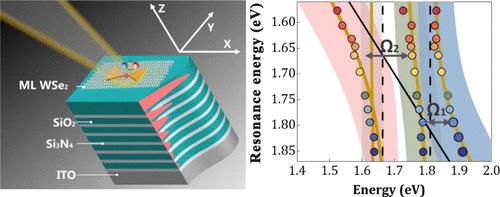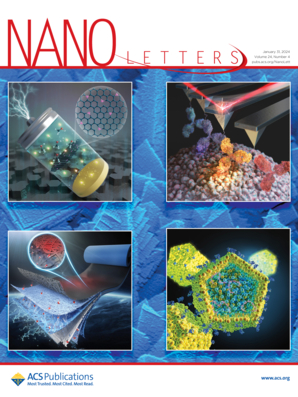Enhanced Light–Matter Interaction with Bloch Surface Wave Modulated Plasmonic Nanocavities
IF 9.6
1区 材料科学
Q1 CHEMISTRY, MULTIDISCIPLINARY
引用次数: 0
Abstract
Strong coupling between nanocavities and single excitons at room temperature is important for studying cavity quantum electrodynamics. However, the coupling strength is highly dependent on the spatial light-confinement ability of the cavity, the number of involved excitons, and the orientation of the electric field within the cavity. By constructing a hybrid cavity with a one-dimensional photonic crystal cavity and a plasmonic nanocavity, we effectively improve the quality factor, reduce the mode volume, and control the direction of the electric field using Bloch surface waves. After transferring a monolayer of WSe2 sandwiched in the hybrid nanocavities, a Rabi splitting of approximately 186 meV is obtained and the number of excitons involved in the coupling is reduced to 8. This is the smallest number reported to date for transition metal dichalcogenide (TMD) based systems, with an effective coupling strength per individual exciton reaching 17.6 meV, which is nearly double the highest reported value.

布洛赫表面波调制等离子体纳米腔增强光-物质相互作用
室温下纳米腔与单激子之间的强耦合是研究腔量子电动力学的重要手段。然而,耦合强度高度依赖于腔的空间光约束能力、参与激子的数量和腔内电场的方向。通过构建一维光子晶体腔和等离子体纳米腔的混合腔,有效地提高了质量因子,减小了模体积,并利用布洛赫表面波控制了电场方向。将单层WSe2转移到杂化纳米腔中后,得到了约186 meV的Rabi分裂,参与耦合的激子数量减少到8个。这是迄今为止报道的基于过渡金属二硫化物(TMD)的系统中最小的数字,每个激子的有效耦合强度达到17.6 meV,几乎是报道最高值的两倍。
本文章由计算机程序翻译,如有差异,请以英文原文为准。
求助全文
约1分钟内获得全文
求助全文
来源期刊

Nano Letters
工程技术-材料科学:综合
CiteScore
16.80
自引率
2.80%
发文量
1182
审稿时长
1.4 months
期刊介绍:
Nano Letters serves as a dynamic platform for promptly disseminating original results in fundamental, applied, and emerging research across all facets of nanoscience and nanotechnology. A pivotal criterion for inclusion within Nano Letters is the convergence of at least two different areas or disciplines, ensuring a rich interdisciplinary scope. The journal is dedicated to fostering exploration in diverse areas, including:
- Experimental and theoretical findings on physical, chemical, and biological phenomena at the nanoscale
- Synthesis, characterization, and processing of organic, inorganic, polymer, and hybrid nanomaterials through physical, chemical, and biological methodologies
- Modeling and simulation of synthetic, assembly, and interaction processes
- Realization of integrated nanostructures and nano-engineered devices exhibiting advanced performance
- Applications of nanoscale materials in living and environmental systems
Nano Letters is committed to advancing and showcasing groundbreaking research that intersects various domains, fostering innovation and collaboration in the ever-evolving field of nanoscience and nanotechnology.
 求助内容:
求助内容: 应助结果提醒方式:
应助结果提醒方式:


